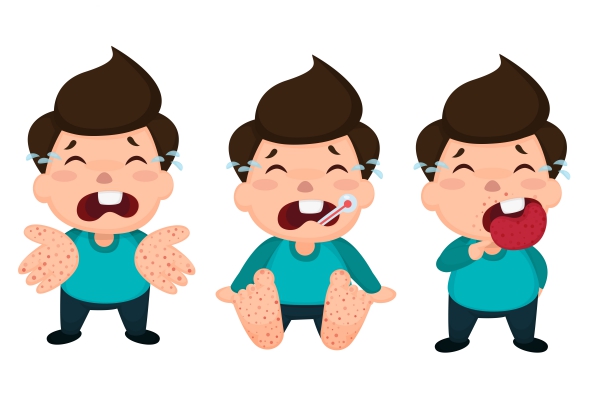What is Hand, Foot and Mouth Disease (HFMD)?
Hand, foot and mouth disease (HFMD) is an infection caused by a virus that has a characteristic vesicular rash in the mouth as well as on the hands, feet, buttocks or genital area. It is a common and potentially fatal disease, in some rare cases, in children aged below 5 years. The virus that is responsible for HFMD is the Coxsackievirus A. In some regions, it has been found that Enterovirus 71 can also cause HFMD outbreaks.
In the United States, the epidemics of HFMD usually occur during summer to early fall months. However, few cases may also arise all throughout the year. The disease is a particular burden in Asia. HFMD affects boys and girls equally. Furthermore, HFMD is a contagious viral infection.
What causes HFMD?
HFMD is a viral infection that arises most commonly due to Coxsackievirus A. Enterovirus 71 is also known to cause the disease. The causative pathogens are usually transmitted via fecal-oral route (contamination through stools) or through direct contact with open skin lesions and oral secretions. Once the virus enters the body through these mechanisms, it develops in the bloodstream leading to viremia. The virus may also be transmitted through respiratory droplets during sneezing or coughing as it can get in contact with skin lesions or mucous membranes.
The disease is common among children as they are more prone to catching the disease since they often put their hands in their mouth. The child is most infectious (able to transmit the infection) during the first weeks of the disease. However, despite disappearance of symptoms, your child may still be able to transmit the infection to other children as the virus remains in the body for a while. Adults may also pass on the virus despite not having any symptoms of infection.

What are the signs and symptoms for HFMD?
Once a child catches the virus, it usually takes around a week before the appearance of symptoms. The following signs and symptoms are usually present in HFMD:
- Sore mouth
- Sore throat
- Malaise
- Lesions with vesicles in the mouth, on the tongue and/or the hard palate
- Red lesions on mucous membranes which are usually painful
- Fever
- Red skin lesions on the palms, soles and buttocks
- Loss of appetite
If the above symptoms appear, it is important to seek medical help as many medical conditions and infections can present in similar ways. Therefore, your doctor will have to make the proper diagnosis and rule out other possible diseases.

How is the diagnosis of HFMD made?
To make the diagnosis of HFMD, your doctor or your child’s doctor will start by taking a detailed history to know more about the symptoms present. He/she will then proceed with a physical examination. The diagnosis of HFMD is usually made based on the clinical presentation. In most cases, laboratory tests are not necessary.
However, if the condition is mimicking other diseases that may be more severe, further evaluation is warranted to rule out potentially serious conditions. A sample of the affected skin may be taken through a biopsy for further examination. In this test, the virus will be looked for and identified. Other body secretions such as saliva, fluids from mucosal lesions or stool can also be used for the identification of the virus. Blood tests are also available to confirm the diagnosis. In some cases, it is also important to identify whether the disease is caused by coxsackievirus or enterovirus as this can determine the course of the disease.

How is HFMD treated?
There is no specific treatment for HFMD. The treatment is mostly targeted towards the symptoms present in order to alleviate them. It is recommended to consume a lot of fluids to prevent dehydration as it is the most common possible complication associated with the disease. Cold liquid are usually preferred. It is advised to avoid consumption of spicy or acidic substances as these may cause discomfort.
If the painful lesions are not allowing oral consumption of fluids, you may have to be hospitalised so that fluids are given to you through your veins. Antipyretic medications may be prescribed to bring down the fever. Painkillers such as acetaminophen or ibuprofen are often given to alleviate any associated pain.
Research is currently being done to find a specific treatment for the disease. Several medications have found to be promising.
How can HFMD be prevented?
There is no vaccine available against HFMD at present. However, studies are being done as a vaccine would be desirable especially against the disease caused by enterovirus 71. For now, the following measures may help in preventing the spread of the disease:
- Frequent and thorough hand-washing: This is especially important after using the toilet or changing a diaper and before eating or preparing food. Hand-sanitizers are also helpful.
- Appropriate cleaning and disinfecting of common areas: This includes child care centres where proper cleaning and disinfecting of shared spaces and items is particularly important. The virus may be present on an object for days and a child can catch it if he/she touches the object and puts the contaminated hand in the mouth.
- Isolation: If your child has the disease, it is important to keep him/her away from other children to prevent further transmission of the infection.

What is the prognosis for HFMD?
HFMD which is caused by coxsackievirus most commonly resolves on its own within 7-10 days. Complications are also rare in these cases. In some cases, the oral lesions may be so severe and painful that it may interfere with feeding and results in dehydration.
If the disease is due to enterovirus 71, a more severe form may arise. It commonly involves the brain leading to neurological complications.

Source:
Schwartz, R., 2020. Hand-Foot-and-Mouth Disease (HFMD)
Thomas I, Janniger CK. Hand, foot, and mouth disease. Cutis. 1993 Nov. 52(5):265-6.
J. Alastair, I. and Simon, M., 2016. Davidson’s Essentials of Medicine. 2nd ed. London: ELSEVIER.
Parveen, K. and Michael, C., 2017. Kumar & Clarks Clinical Medicine. 9th ed. The Netherlands: ELSEVIER.


